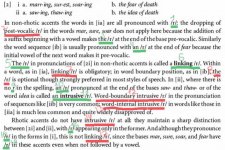Alexey86
Senior Member
- Joined
- Nov 3, 2018
- Member Type
- Student or Learner
- Native Language
- Russian
- Home Country
- Russian Federation
- Current Location
- Russian Federation
Would you please help me understand the use of articles with r in the following passage from The Cambridge Grammar of the English Language by R. Huddleston (I numbered all the uses of r in the passage):

I understand the green ones and don’t understand the red ones.
Why does the author vary the count and the non-count use of r?
(8) is part of a general statement. Why does it take the?

I understand the green ones and don’t understand the red ones.
Why does the author vary the count and the non-count use of r?
(8) is part of a general statement. Why does it take the?